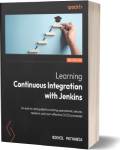Learning Continuous Integration with Jenkins – Third Edition
Software Development
Book Details
Book Title
Learning Continuous Integration with Jenkins – Third Edition
Author
Nikhil Pathania
Publisher
Packt Publishing Ltd. City: Birmingham
Publication Date
2024
ISBN
9781835087732
Number of Pages
389
Language
English
Format
File Size
5.58MB
Subject
software-development/devops
Table of Contents
- Contributors
- About the author
- About the reviewers
- Preface
- Part 1: The Concepts
- Chapter 1: The What, How, and Why of Continuous Integration
- What is continuous integration?
- How to practice continuous integration
- Why is continuous integration crucial?
- Summary
- Questions
- Answers
- Further reading
- Part 2: Engineering the CI Ecosystem
- Chapter 2: Planning, Deploying, and Maintaining Jenkins
- Technical requirements
- Planning your Jenkins setup
- Deploying your Jenkins setup
- Maintaining your Jenkins setup
- Summary
- Questions
- Answers
- Further reading
- Chapter 3: Securing Jenkins
- Technical requirements
- Configuring user authentication and permissions
- Understanding CSRF protection in Jenkins
- Using Jenkins Credentials
- Summary
- Questions
- Answers
- Further reading
- Chapter 4: Extending Jenkins
- Technical requirements
- Connecting Jenkins to a version control system
- Connecting Jenkins to SonarQube
- Connecting Jenkins to Artifactory
- Summary
- Questions
- Answers
- Further reading
- Chapter 5: Scaling Jenkins
- Technical requirements
- Understanding Jenkins’ distributed build architecture
- Creating on-demand build agents on Kubernetes
- Creating on-demand build agents on Azure
- Summary
- Questions
- Answers
- Further reading
- Part 3: Crafting the CI Pipeline
- Chapter 6: Enhancing Jenkins Pipeline Vocabulary
- Technical requirements
- Building vocabulary for pipeline code
- Using built-in tools to construct pipeline code
- Summary
- Questions
- Answers
- Further reading
- Chapter 7: Crafting AI-Powered Pipeline Code
- Technical requirements
- Introducing AI, language models, and ChatGPT
- Guidelines for effective interaction with ChatGPT
- Constructing a pipeline code using ChatGPT
- Understanding the limitations of ChatGPT
- Summary
- Questions
- Answers
- Chapter 8: Setting the Stage for Writing Your First CI Pipeline
- Technical requirements
- Understanding the software project for CI
- Creating a repository on GitHub for your project
- High-level CI design
- Creating a webhook on the repository
- Setting up a project in SonarQube
- Using Artifactory as a Docker registry
- Creating a Kubernetes Secret on AKS
- Summary
- Questions
- Answers
- Chapter 9: Writing Your First CI Pipeline
- Technical requirements
- Writing CI pipeline code
- CI in action
- Summary
- Questions
- Answers
- Further reading
- Part 4: Crafting the CD Pipeline
- Chapter 10: Planning for Continuous Deployment
- Technical requirements
- Understanding Continuous Deployment
- Planning Continuous Deployment
- Summary
- Questions
- Answers
- Further reading
- Chapter 11: Writing Your First CD Pipeline
- Technical requirements
- Writing CD pipeline code
- CD in action
- Summary
- Questions
- Answers
- Further reading
- Chapter 12: Enhancing Your CI/CD Pipelines
- Technical requirements
- Using GitHub Copilot to write pipeline code
- Using Jenkins Shared Libraries
- Discarding old builds in Jenkins
- Catching security vulnerabilities early in code
- Summary
- Questions
- Answers
- Further reading
- Index
- Other Books You May Enjoy
